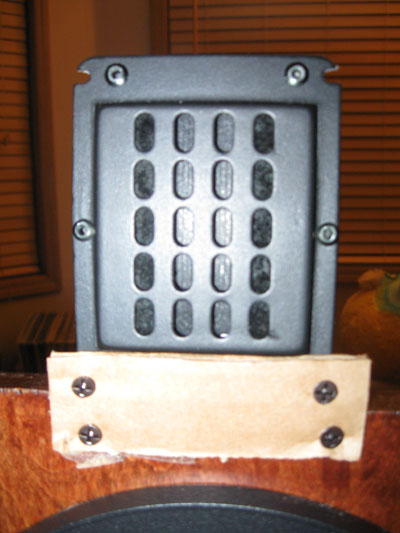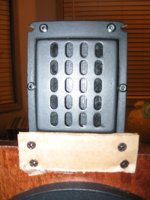By the way: did you install the driver software that (hopefully) came with the USB-RS232 cable?
About EQ: I usually ignore very small peaks and dips to keep the number of EQ points down to a minimum. It usually sounds better. Very small peaks and dips have a tendency to change a lot with mic position as well. I focus on the overall respons. I think its more important that the overall balance across the entire frequency range is even, than to correct every little small bump in the response. I hope you get my point.
About EQ: I usually ignore very small peaks and dips to keep the number of EQ points down to a minimum. It usually sounds better. Very small peaks and dips have a tendency to change a lot with mic position as well. I focus on the overall respons. I think its more important that the overall balance across the entire frequency range is even, than to correct every little small bump in the response. I hope you get my point.
This is the normal Neo3 tweeter.
What lower frequencies do you mean? The main EQ's I did are notching of the Peak around 13 khz for the Neo, lifting its roll-off below 2.5 khz, a notch on the dipole peak of the AL170 (-13 dB at 1.5 khz) en 6 dB/oct lowpass on the woofers to equalize dipole-loss.
What lower frequencies do you mean? The main EQ's I did are notching of the Peak around 13 khz for the Neo, lifting its roll-off below 2.5 khz, a notch on the dipole peak of the AL170 (-13 dB at 1.5 khz) en 6 dB/oct lowpass on the woofers to equalize dipole-loss.
If small bumps are worth EQ'ing or not should be determined by listening. When you get the remote software up and running, sit in your listeining chair, play music and then turn your small EQ points on and off. I've found that very small EQ points, say 1 dB and/or Q above 10, is not worth the effort.
You are right, audibility should still be determined. I'll test it when I get the remote-control of the DCX working. I've installed the driver, but it still doesn't work. It keeps saying COM port in loop mode. The Behringer software automatically sets COM3, but there are no other options available. Any suggestions?
The higher mid to high section of the dipole now sounds superb! In the midrange there is however still room for improvement. With large scale symphonic works at high volume levels I still notice a bit of congestion. I do believe I am on the right track!
The higher mid to high section of the dipole now sounds superb! In the midrange there is however still room for improvement. With large scale symphonic works at high volume levels I still notice a bit of congestion. I do believe I am on the right track!
Last edited:
Do not attach the USB-serial cable yet. Install the driver, reboot the computer, and then attach the cable. Windows should pop up with some "installing..." stuff, and automatically recongnize the USB-serial cable. It should also appear as COM ports in Windows Device Manager (under Ports). Check that first, the Behringer remote will not work unless the USB-serial is properly installed in Windows.
This is the normal Neo3 tweeter.
What lower frequencies do you mean? The main EQ's I did are notching of the Peak around 13 khz for the Neo, lifting its roll-off below 2.5 khz, a notch on the dipole peak of the AL170 (-13 dB at 1.5 khz) en 6 dB/oct lowpass on the woofers to equalize dipole-loss.
Thanks, what I meant was the "lifting its roll-off below 2.5 khz". Your description is excellent. It seems I have a pair of tweeters to purchase
What is the physical difference between normal and PDR version anyway? Does the PDR use some form of phase shield?
I'm not sure about the difference between the two, but I think it is just that the PDR uses some sort of felt padding at the edges of the membrane as to make it acoustically narrower at higher frequencies, while the lower frequencies are affected to a lesser degree. There might be more, though.
http://www.gr-research.com/pdf/NEO3pdr.pdf
http://www.gr-research.com/pdf/NEO3pdr.pdf
The higher mid to high section of the dipole now sounds superb! In the midrange there is however still room for improvement. With large scale symphonic works at high volume levels I still notice a bit of congestion. I do believe I am on the right track!
You could try to make a simple swing and suspend the midrange just to check that out, see if you like it or not. It was a great success for me, really cleaning up the midrange!
The Neo3 PDRW has felt covering the outer 1/2 of the driver's radiating width, the idea being to have a narrower radiating area at higher frequencies. In the sims the Neo3 has better CD, but a narrower response at higher frequencies. Hopefully keyser will get to run direct measurements comparing the two. So far, he's been able to get better results with the Neo3 than I have with the PRDW 

Attachments
Over here, posts 5 and 7.I'm not sure about the difference between the two, but I think it is just that the PDR uses some sort of felt padding at the edges of the membrane as to make it acoustically narrower at higher frequencies, while the lower frequencies are affected to a lesser degree. There might be more, though.
Linkwitz's test indicates that running the Neo3W down as low as I currently do might be asking a bit too much from the driver. I should measure its distortion myself, but I like to sometimes get ahead of myself  : I've found a great solution! I could cross the Neo3W around 2 khz (which it should handle easily, I guess) and mate it with the BMS 5N155:
: I've found a great solution! I could cross the Neo3W around 2 khz (which it should handle easily, I guess) and mate it with the BMS 5N155:
- Small motor, so probably nicely symmetrical
- Small flange compared to driver size
- High efficiency and power handling, which is handy because of the fact that I'll need approx. 13 dB of boost
- Small motor, so probably nicely symmetrical
- Small flange compared to driver size
- High efficiency and power handling, which is handy because of the fact that I'll need approx. 13 dB of boost
Sound has to get around the spider before the motor matters. Small woofers all seem to be rather constricted.
How low do you want to take 5N155?
It's just a thought. You're probably right though, the spider is more important than the motor's size. I've got a pair of Seas L12's lying around I'll try first.
The AL170's are crossed around 300 hz at the moment. They are never excursion limited - maximum SPL is restricted by voice-coil heating. I reckon the more efficient BMS, with its much higher power handling as well, should be able to go a bit lower. Maybe close to 200 hz.
About the differences between Neo3 and Neo3PDR:
I've used the PDR without a baffle for some time, but around 7 kHz there was an interference dip on-axis and a peak at 45 degrees. The treble was very sensitive to changes in listening angle.
I've been using Neo3 without a baffle for about 6 months now, which has nearly perfectly solved the problem. The Neo3 is definitely the better choice, the difference is audible.
It also has a slightly higher sensitivity, which could alleviate thermal issues (which could be a problem according to Linkwitz).
I'm not sure if I still have comparable measurements... if I can find something I'll post it here.
I've used the PDR without a baffle for some time, but around 7 kHz there was an interference dip on-axis and a peak at 45 degrees. The treble was very sensitive to changes in listening angle.
I've been using Neo3 without a baffle for about 6 months now, which has nearly perfectly solved the problem. The Neo3 is definitely the better choice, the difference is audible.
It also has a slightly higher sensitivity, which could alleviate thermal issues (which could be a problem according to Linkwitz).
I'm not sure if I still have comparable measurements... if I can find something I'll post it here.
Last edited:
So you want to go lower with a smaller driver by throwing more power at it. Have you taken a look with Linkwitz's power limited dipole SPL spreadsheet or a similar tool to see if the extra power offsets the SPL reduction due to the decreased driver size and that the excursion remains small enough to satisfy your distortion requirements? (See discussion here on what to plug in for the dipole separation.) Fighting underlying physics tends to degrade results rather than improve them, so if you want to cross from the U baffle at 200Hz I would think you'd be looking at 8 to 10 inch woofers.I reckon the more efficient BMS, with its much higher power handling as well, should be able to go a bit lower. Maybe close to 200 hz.
I realize that. However, the difference in sensitivity is 3 dB and the difference in power handling is 3 dB as well. That's a 6 dB difference in max SPL. The difference in dipole loss between the AL170 at 300 hz and the BMS at 200 hz is about 6 dB. That means max SPL should be approximately the same. I don't think this contradicts physics. I'm not sure crossing at 200 hz would be optimal from an excursion point of view, though. I'll have to determine that by experiment, but I'd like to put the crossover as low as possible, so that it's in the modal range which should make the transition less audible.
Sounds about right. But since you find you're power limited with the AL170 I'm not sure why you'd want to swap it out for another driver that would still leave you power limited at the desired crossover frequency. Particularly as running drivers at their power limit creates a host of problems. My point about physics was changing to a larger driver would increase the efficiency of the system, so you'll see less thermal compression, suspension nonlinearity, and so on.
I used to cross the AL170 at a lower frequency, somewhere between 200 hz and 250 hz. At that time, when I was listening at a very high volume level for a long time, the magnet of the driver got a little warm. Not a good thing. Then I increased the cross frequency to about 300 hz. Now it's just fine. So, the BMS probably will be fine playing a little lower.
One of the main goals of my system is constant directivity. Wide dynamic range comes second to that. If I have have to increase the crossover frequency between the mid and tweeter because the tweeter runs out of steam at the low cross frequency, the last thing I want to do is use a larger midrange driver.
One of the main goals of my system is constant directivity. Wide dynamic range comes second to that. If I have have to increase the crossover frequency between the mid and tweeter because the tweeter runs out of steam at the low cross frequency, the last thing I want to do is use a larger midrange driver.
- Status
- This old topic is closed. If you want to reopen this topic, contact a moderator using the "Report Post" button.
- Home
- Loudspeakers
- Multi-Way
- Unbaffled Dipole
